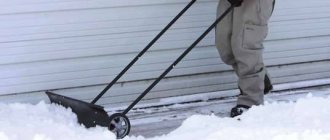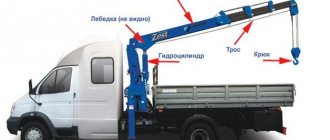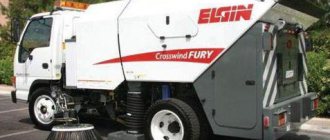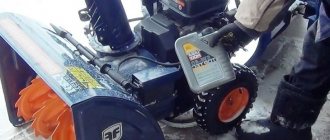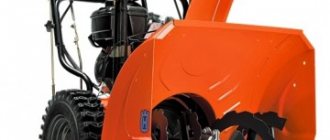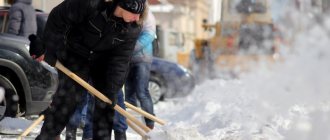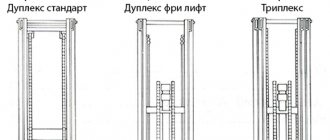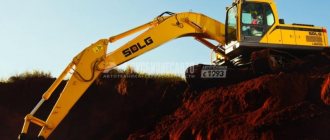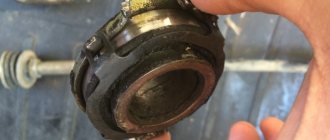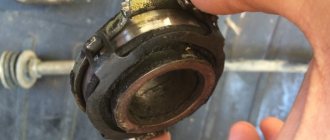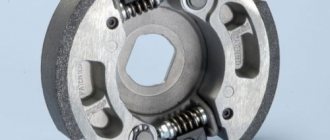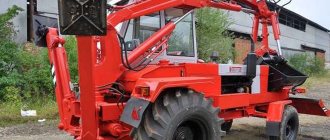Precipitation in the form of large volumes of snow causes a lot of trouble for residents of private houses, owners of dachas and suburban areas.
A modern unit called a snow blower (snow blower) helps to clear snowdrifts.
With this device you can easily and quickly clean paths, driveways, gardens, yard, and any other areas.
Some modifications of this tool are specially designed to work in difficult climatic conditions, but first things first.
Areas of application for snow removal equipment
Snow removal equipment is widely represented by various types; it can be used for cleaning private home plots, dacha areas, clearing industrial sites, parking lots, city streets, squares and, of course, highways and airports. We have already talked about equipment for winter road maintenance, now we are talking about devices for cleaning local areas.
Snow removal at airports
Increased demands are placed on the condition of the surface of runways and taxiways at airports.
To clear them of snow, equipment is used that is capable of cleaning large areas in the shortest possible time and with high quality:
- plow-brush machines;
- auger snow blowers;
- reactive units.
Large-sized airfield vehicles are equipped with turbojet blowing devices, special brushes, floating dumps, and magnetic separators.
The equipment is mounted on powerful chassis KAMAZ, KrAZ, MERCEDES, MAN, etc.
To remove a thin layer of snow and ice, liquid or solid deicing chemicals are used.
Work to clean up airport areas should be carried out as quickly as possible to accommodate the gaps between takeoffs and landings without interfering with aircraft.
Airfield snow blower
Advantages and disadvantages
Like any equipment, snow removal machines have their advantages and disadvantages. The advantages of mechanized snow removal include:
- Speed and quality of work. Mechanisms cope with snow debris better than people. One device can replace 4-5 people.
- Simple controls.
- Maneuverability.
- Wide range and prevalence. There are many types of snow blowers to suit every budget and size of area.
- Ease of maintenance and repair.
Additional Information.
Snow blowers practically do not fail and only require replacement of wearing parts.
Making any technique perfect is not an easy task. Snow removal machines are no exception. They have their drawbacks:
- The first of them is the price and the need for constant costs of fuel (electric or liquid). Although this is more a question of income and the desire to pay for amenities.
- Requirement for an energy source. The operating range of the mechanisms is limited by the length of the power cord and the battery capacity for electric models, and the volume of the fuel tank for gasoline ones. In addition, the latter pollute the air with exhaust gases.
- The need to monitor technical condition.
- Noisy operation.
Jet snow blowers
Snow blowers are used to clear snow from station tracks, turnouts, and station necks. The basis of the equipment is a platform or railcar on which a turbojet engine is installed. Hot exhaust gases are blown onto the path through a nozzle located at the rear of the car. They effectively blow away, melt and then evaporate snow.
The Jet Blower rail jet snow blower is a machine with a powerful jet engine. This rail cleaner is used on access roads and depot areas. The principle of operation of the device is that a powerful jet blows away snow from all objects that get in its way. The jet temperature is 315°C, so most ice and snow evaporate.
Important! The main disadvantage of a jet snow blower is the loud noise produced by the equipment during operation. For this reason, jet rail cleaners are used within the depot.
Manual snow blower: scope of the device
A manual snow blower is useful for cleaning local areas in rural areas, for residents of cottage communities, and in the city for cleaning parks and squares. Using the equipment, you can put the yard in order after a snowfall, free up space for parking a car, access to the garage, and remove fallen snow from the territory of industrial enterprises and construction sites.
Recommendations for selection
The best snow blower model is not necessarily the most expensive option. Before purchasing a device, it is much more important to clearly define the required functionality and features of use.
Will you be cleaning large areas? How often? How much snow will need to be removed? Are you willing to pay extra for additional features that improve the usability of your snow blower? Do you need a universal tractor that will also be useful in other seasons?
This is an approximate list of questions that you need to consider before purchasing a snow blower. The correct answers will help you manage your purchase budget wisely and enjoy using the chosen model.
What you need to know before buying a snow blower
Remembering the well-known proverb - prepare your sled in the summer, it is best to purchase a snow removal machine at the end of winter or in the spring, when stores have sales of out-of-season goods. When choosing equipment, you need to take into account the purchase budget, the cost of fuel or electricity, the area to be processed, as well as the design and weight of the machine.
It is worth considering that snow blowers can be self-propelled - driven on a chassis and manual, which the operator must push forward. The former are more convenient, but more expensive; the latter are easier to manage, but require more effort. In addition, each type has its own individual pros and cons.
Engine power
The power of snow removal equipment determines its ability to cope with loads. For icy and compacted snow, as well as for cleaning a large area, a strong unit is required, and for cleaning compact areas, low-power machines are also suitable.
The scope of application of the machines depends on the engine power:
- up to 5 l. With. – only enough to clean steps, paths or small areas.
- 5 – 8 l. With. – suitable for cleaning a plot of 5-6 acres and will be useful to owners of private houses or summer cottages. Such machines are able to cope with low snowdrifts or compacted masses of snow.
- 8 – 10 l. With. – can process areas of up to 15 acres and clear away snowdrifts with dense crust. This technique is suitable for country houses or industrial sites.
- over 10 l. With. – for cleaning large deposits of snow or large areas.
Additional Information.
The more powerful the engine, the louder the snow blower will run and consume more fuel and oil.
Snowblower weight
Small snow removal equipment is divided into three main categories, depending on weight:
- Lightweight – up to 40 kg. Mainly represented by manual control models;
- Medium – weighing from 40 to 90 kg;
- Heavy - weighing over 90 kg.
Lightweight manual snow blowers are easy to carry, but the lighter the equipment, the worse its performance. Heavier models cope better with snow mass, especially with stale, dense snow. At the same time, it is more difficult to move such machines around the site. And they require more physical effort to work.
Release range
How far a snow blower can throw snow depends on several factors, including wind, the type of snow (wet or freshly fallen), and the degree of installation of the canopy on the gutter. But the main indicator is the power of the machine.
Depending on the engine power, the equipment can throw snow over the following distance:
- 5 l. With. – less than 5 meters;
- 6.5 l. With. – 5-6 m;
- 8 l. With. – 7-9 m
- 10 l. With. – up to 12 m.
Working width
The smaller the grip, the more passes the machine operator will have to make, but at the same time, a snow blower with a large bucket is less maneuverable, has a larger turning radius and requires significant physical effort from the operator (for manual models).
Non-self-propelled machines are equipped with a bucket about 50 cm wide, and snow blowers with a chassis drive are capable of clearing a strip of 70-90 cm in one pass. The maximum width of the bucket of small-scale mechanization equipment for snow removal can reach 114 cm.
Screw material
The auger is an important element of a snowblower. With its help, snow is crushed and moved. Depending on the type of device, it can be rubberized or metal. The first is often used on single-stage machines; it does not damage tiles and other coatings.
Metal gear – used in two- and three-stage devices. This auger copes well with dense and deep snow cover. He is not afraid of crushed stone, sand and soil that may come across when cleaning unpaved areas.
Additional options
A home snow blower can be additionally equipped with a headlight, which is very convenient on short winter daylight hours. Some models also provide the ability to adjust the lighting range.
Premium snow blowers are equipped with heated handles to protect your hands from the cold.
Price
Cost is one of the important factors for most people. Therefore, some try to purchase the unit that best suits them at the lowest price , sacrificing some minor characteristics, while others are ready to buy even robotic snow blowers for hundreds of thousands of rubles
The cost of inexpensive devices starts from 4 thousand rubles (low-power electric shovels). The price of the most expensive units exceeds 200 thousand rubles, but they provide enormous performance and are able to cope with any snow. Separately, there are autonomous devices, for example, a robotic snow blower.
Features of different types of engines
As mentioned above, snow removal equipment can have a gasoline or electric drive. Each engine type has its own pros and cons.
Electric models
Snow removal equipment with an electric motor is suitable for courtyard areas and small areas. It is lighter, more compact than gasoline and has no harmful emissions. An example of such a machine is the Huter SGC cleaner, which is often called the “Hutor”.
The advantages of electric snow blowers include:
- maneuverability;
- quiet operation;
- no emissions;
- ease of maintenance;
- launch at the touch of a button;
- lower price.
Main disadvantages:
- low power - only fresh snow can be removed;
- the need to take breaks from work every 30 minutes to allow the engine to cool down;
- dependence on cable length and battery capacity;
- danger of electric shock if handled carelessly.
In addition, it is worth considering that electric cars are not self-propelled.
Gasoline snow blowers
A gasoline snow blower is a type of cleaning equipment suitable for cleaning large areas. The main advantages of the device:
- independence from the power grid;
- there are self-propelled models;
- snow throw distance;
- good performance - the machine can even cope with compacted snowdrifts or ice.
Disadvantages of equipment with a gasoline engine:
- large dimensions and weight;
- wide turning radius;
- very noisy work;
- gasoline exhausts;
- high price;
- cost of consumables.
Note!
All gasoline purifiers require constant maintenance. And if the equipment is idle for a long time, it is necessary to drain fuel and oil from them.
Rating of the TOP 5 best models
| Place | Name | Price |
| TOP 5 best snow blowers | ||
| 1 | Daewoo Power Products DAST 3000E | 17 000 ₽ |
| 2 | Daewoo Power Products DAST 6560 | 17 000 ₽ |
| 3 | AL-KO SnowLine 46E | 48 000 ₽ |
| 4 | Huter SGC 4000 self-propelled | 27 000 ₽ |
| 5 | MasterYard ML 7522B | 54 000 ₽ |
How to determine the level of autonomy of a snow blower
The most limited in terms of autonomy are models powered by electricity. They are suitable for small areas, because... their operating radius is limited by the length of the wire, which, moreover, often interferes during operation.
Battery-powered snowplows are considered partially autonomous. The absence of connection to a power source allows you to expand the operating radius. At the same time, cheaper models have a smaller battery capacity, which affects the operating time of the equipment.
The most autonomous machines for mechanized snow removal with internal combustion engines are considered. Depending on the engine power, such models can cope not only with old snow, but also with ice.
Additional functions
Additional functions include everything that does not affect the snow removal process, but makes it easier to one degree or another:
- convenient chute control handle;
- folding handle;
- electric starter;
- headlight;
- heated handles;
- possibility of installing a brush.
How to Choose Between a Single-Stage, Two-Stage, and Three-Stage Snow Blower
Small snow removal equipment is classified depending on the type of auger assembly. Augers are:
- Single stage
- Two-stage
- Three-stage
Single-stage snow blowers have one working mechanism - an auger, which simultaneously moves the snow to the middle, grabs it and throws it forward or through a special chute. Such models are less productive than two- or three-stage ones. As the auger rotation speed increases, the throwing distance increases.
Single-stage snow blowers come primarily in electric, non-propelled, and wearable models. The latter are sometimes called electroshovels. These models are only suitable for clearing soft, freshly fallen snow.
In two-stage machines, a second stage of snow processing is added to the auger - an impeller. She is responsible for throwing the supplied snow through the chute. Naturally, this equipment is already more powerful, it can even cope with icy snow and is used on medium or large sites, wide sidewalks or parking lots.
The most powerful and productive are three-stage snow blowers. They are used more in public utilities and on large volumes. For these models, the auger-rotor unit is disconnected: the auger collects snow and feeds it to the rotor located in the center. In turn, the rotor increases the flow rate to the impeller and facilitates the movement of the machine on dense or stale snow.
These features make the three-stage snow blower a little big for households. Having such a “monster” at home is expensive, and its productivity is higher than required. But one- and two-stage snow blowers are just right. It all depends on the size and features of the site and, of course, on the budget.
Cars for the city
The maintenance of city roads differs significantly from the maintenance of suburban highways.
High intensity and heterogeneous traffic flow, congestion of sidewalks and vehicle stops dictate increased requirements for street cleaning.
Snow removal work must be carried out simultaneously throughout the city, which requires the presence of a large number of high-performance road equipment.
There are special requirements for cleaning city roads:
- Creating minimal disruption to public transport. The speed of snow removal equipment when clearing roads should be close to the speed of traffic flow.
- The anti-icing reagents used and the disposal of snow from city streets should not have a negative impact on the environment.
- When raking snow masses into snow banks, it is necessary to remove snow as soon as possible at all intersections and road junctions, public transport stops, and exits.
The speed and quality of road cleaning is increased by the simultaneous use of several units of equipment, lined up sequentially, across the entire width of the roadway.
If snow is practically not removed from the highways and is moved to the side of the road, then from city streets, courtyards and squares it must be immediately transported to snow dumps or snow melting stations.
After snowplows pass through city streets and courtyards, shafts remain that must be removed within the time limits specified by GOST R 50597-2017 “Roads and Streets”, instructions, rules and guidelines of local authorities.
Table 1. Main regulatory deadlines for removing snow and ice formations on city roads and highways.
| Type of formations | Road category | Time frame for elimination |
| loose snow | expressways, highways, city roads with controlled traffic | within 4 hours (up to 3 hours - rural) |
| highways, transport and pedestrian | within 5 hours, (up to 4 hours - rural) | |
| courtyard driveways, local roads | within 6 hours | |
| one way roads | till 12 o'clock | |
| Ice | expressways, main roads, city roads | within 4 hours (up to 5 hours - rural) |
| transport, pedestrian and courtyard passages | within 5 hours | |
| residential roads | within 6 hours | |
| one way roads | within 12 hours |
For loading snow, rotary snow loaders are used, with a guide casing for raking and loading snow shafts. The snow blower uses augers to crush the snow captured by the bucket and feed it to the rotor impeller. Through the guide casing it is thrown into the dump truck standing on the side.
A rotary snowplow and a dump truck occupy two lanes at once, creating traffic congestion.
Snow blowers that are capable of loading trucks following the loader in one lane are considered more convenient equipment for city roads.
The length reserve of the conveyor boom allows loading through the truck cabin in the direction of travel.
Paw snow blower
Caring for the snow blower during active use
In order for snow removal equipment to last longer, it is necessary to properly care for the equipment:
- Before each use of an internal combustion engine snow blower, check the oil level.
- If storage is carried out in a warm room, the device should be taken outside 5-10 minutes before starting work.
- After operation, models with a gasoline engine should be allowed to run without load for at least 1 minute.
- Clear the car of any remaining snow.
- For electric battery models, remove the battery.
Starting the auger
The first start of the auger can be carried out simultaneously with or after checking the motor. To do this, the auger operation switch is switched to operating mode. In this state, it needs to be held for 5-10 seconds, during which you need to make sure that the rotation occurs without jerking and that the auger generally moves. If this is not the case, then it is necessary to adjust the length of its cable.
The same procedure will be required if, after stopping, the auger does not stop completely, but trembles a little. The entire process of adjusting the cable is described in detail in the instructions, and different manufacturers may do it differently.
The next important stage in the operation of the auger is checking the gearbox. To do this, you need to fix the auger activation lever and let the equipment run idle for about 2 hours. After stopping, you need to try the gearbox. It should be barely warm or cold, but if it gets hot, then there is a defect in it, and the likelihood of an early breakdown is very high.
When to buy
We recommend purchasing a snow blower in winter , immediately after the first snow falls, since you can return or exchange a fully functional unit that you didn’t like within 14 days .
This is written in Article 25.1 of the PPA, so the seller does not have the right to refuse you. If you purchase a snow thrower long before the snow falls, you will not be able to check its operation and, if necessary, exchange it for a more powerful one or one that suits your conditions.
We also recommend that after choosing a specific model, type its name on the Internet and compare offers. This will help you find stores that offer this device on the best terms, and also offer various promotions or discounts .
Which ones are suitable?
Detergents vary by category. Before purchasing, you should check whether the chemicals are suitable for the type of floor covering and type of scrubber.
5 types of chemical compounds for cleaning:
- For wet cleaning. After washing with this product, the floor covering acquires a glossy shine and an anti-slip effect is noticeable. Detergents of this type do not leave streaks. Recommended for use on demanding natural stone surfaces.
- Universal. Will overcome any stains on various coatings. Available in liquid form, it is a low-foam product.
- Alkaline. The composition includes concentrated hydroxides of alkali and alkaline earth metals. Used to clean old stains and stubborn dirt from polymer and polyurethane coatings.
- Medium alkaline. To remove rust, cement or plaque. Highly active detergent cleans floor coverings from moderate dirt.
- Slightly alkaline. Suitable for daily cleaning, as well as removing fresh greasy or oily stains of soot, soot, carbon deposits.
High-quality detergents take care not only of floor coverings, but also of scrubbing equipment. In the process of creating household chemicals, all the subtleties of the equipment used were taken into account - the product will not harm expensive machines.
